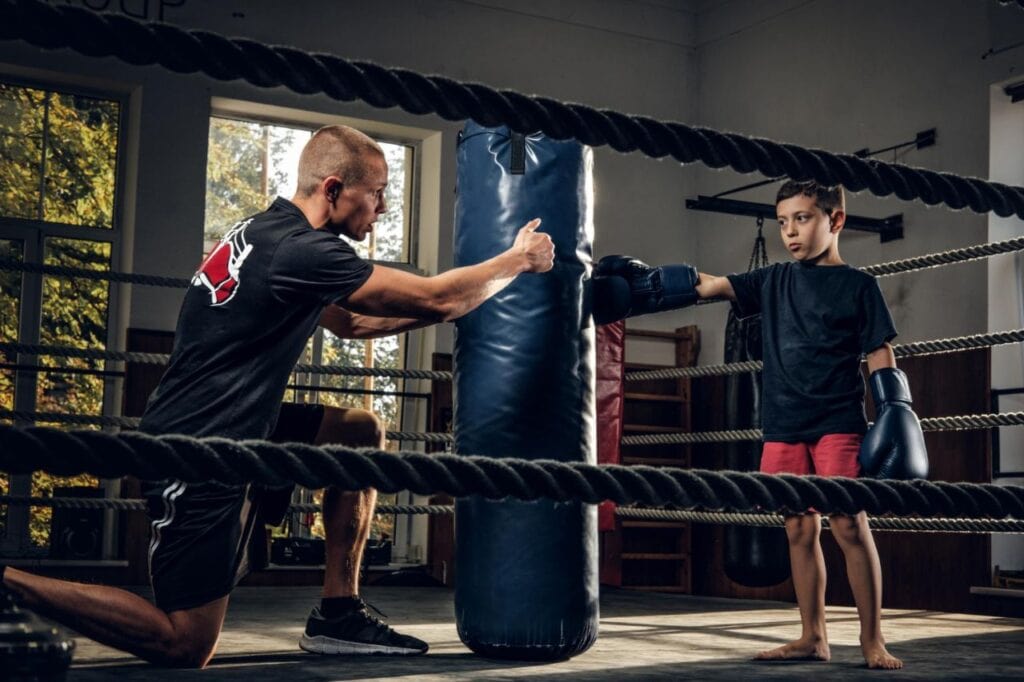Are you interested in learning how to box, but don't know how long you should train for? In this blog post, we will give you an idea of how long a beginner boxer should train.
Keep in mind that everyone is different and there is no one-size-fits-all answer; so be sure to consult with your boxing instructor to get the best advice for your specific situation.
But read on to learn more about how long beginners should train!
Boxing Workout: What To Expect
So, you’ve made the decision to better your life and scheduled your first boxercise class. Congratulations, you are about to embark on an exciting journey that will challenge you to push your limits and break barriers.
Starting anything new can be intimidating, to say the least. However, keep in mind that everyone had their ‘first day’ at one point or another, and these anxious feelings tend to dissipate the moment you step in the club.
Here’s what to expect from your first boxing class:
Your First Class
On the day of your first boxing class, it’s extremely important to arrive 15 to 30 minutes early for a handful of reasons.
First and foremost, with all boxing gyms, fitness programs, and boot camps, there will be some paperwork and liability forms that you’ll need to sign prior to being able to take the class.
Next, the trainer will want to give you a short-and-sweet run-down of the gym to help make you feel more comfortable.
They will show you where the lockers and restrooms are, where the hydration station is so you can refill your water bottle, and of course, the boxing equipment.
Once your hands and wrists are wrapped, it’s GO time!
The Workout
Most boxing classes are 60 minutes long and are usually structured in three “rounds” that include an intense cardio warmup, boxing with intervals of bodyweight exercises, and of course, core work.
All three rounds are extremely challenging and are sure to leave you drenched in sweat from head to toe. In fact, a boxing class can burn anywhere from 500 to 1,000 calories per hour.
Although all gyms are different and some are structured differently, a boxing round is typically done with a heavy bag or by shadowboxing.
Typical Boxing Exercises
Before we dive right into what a typical boxing workout looks like, it’s important to know what some of the exercises are in the workout, as well as what they’re good for!
Running
About 99% of boxers out there run on a daily basis. In fact, running is oftentimes the staple of a boxing workout for many reasons. The first, surprisingly, has nothing to do with the physical aspect of it.
As most boxers will admit, fighting is as much mental as it is physical - if not more. Running helps build mental toughness. When you set a goal for the number of miles you want to run, you have to push yourself in order to get through.
Another benefit of running is endurance. While the mind is important, your body has to also be able to do what the mind wants it to do. Even if you have the drive and mental toughness to do a long battle, you need to make sure your body is conditioned enough to comply.
Running your miles will help to build endurance in your legs, lungs, and overall body. It teaches your body to bring oxygen to your muscles and keeps you in the game longer.
Jump Rope
Ah, the jump rope - a classic boxing exercise! You can most definitely expect to utilize the jump rope throughout your boxing workout. This simple piece of exercise equipment helps fighters to stay on their pivot throughout the fight and teaches them how to be agile with their footwork.
It will force you to stay fast on your toes, which is a must in boxing. Need another reason to jump rope? It’s just plain ol’ fun, especially once you get good.
Shadowboxing
Shadowboxing is where habits are both, this goes for both good and bad habits. There are a couple of things you want to do while shadowboxing to do it right and make sure you are learning good habits.
Always throw to the best of your ability. This means throwing sharp, solid, fast punches - no sloppy and lazy punches! You will build the wrong type of habits if you aren’t putting your best foot forward each time.

You’ll also want to make sure you’re moving you’re head and your feet.
Take rounds off of throwing punches and just focus on footwork and head movement. You see great boxers like Guillermo Rigondeaux and Floyd Mayweather doing this a lot.
At the end of each combo, ask yourself if that was the hardest or fastest punch that you can throw. If the answer is no, throw again faster and harder.
Shadowboxing will help you to build the right reflexes into your systems. It will also aid your coordination and help you to throw punches that won’t leave you off balance when you miss, but still have enough power to knock the other guy out.
Shadowboxing can be a little challenging!
Heavy Bag
The biggest temptation in life isn’t food, riches, or fame. It’s walking by a heavy bag and trying not to hit it!
Punching a heavy bag is arguably the most fun you can have hitting something without getting in trouble, but just because it’s fun doesn’t mean it’s not an effective piece of workout equipment.
Outside of stamina, coordination, speed, and range, the heavy bag is amazing for developing power.
This is where you get to unload and hit the bag as hard as you can, which is ideal for building form and increasing punching power. In every boxing workout, you can expect to work the heavy bag, to practice your combos, and work on perfecting your mix of power, speed, and the form of your punches.
Strength Training
All boxing classes have some form of strength training incorporated into the workout.
A fighter’s body has to not only be able to dish out a beating but take one as well.
Most people think of strength training as lifting incredibly heavy weights and becoming some massive bodybuilder, but this couldn’t be further from the truth!
Think of strength training as performing exercise involving some type of resistance, whether that’s resistance-based equipment, weights, or even your body weight. This form of exercise could involve doing crunches, wall-balls, pushups, squats, or lifting a dumbbell of light-to-medium weight.
Boxing clubs know that strength training is important because it will make you muscles, bones, and joints stronger, allowing you to improve the quality of your workouts.
Putting It All Together
Now that you know what goes into a boxing workout, here is a short outline of a typical boxing workout that you can follow. Feel free to adjust it as needed depending on what shape you’re in and remember to drink plenty of water to keep yourself hydrated because trust us - you’re going to sweat.
Warmup:
- 10 minutes jump rope
- 15 squats
- 15 pushups
- 30 crunches
Shadowboxing:
- 3-minute round: Basic jab, cross, and hook punches
- Rest 30 seconds
- Repeat 5X
Heavy bag workout: basic combinations
- 3-minute round
- Rest 30 seconds
- Repeat 5X
Conditioning:
- 10 pushups
- 10 jump squats
- 1-minute plank
- Rest 30 seconds
- Repeat 5X
Cooldown:
Stretch for 5 minutes
If you’re a newbie to this kind of intensity, do three rounds - not five - and give yourself a full minute of rest between them. Don’t go all out in the first 20 seconds. Be sure to pace yourself.
The Right Way To Train For Boxing!
Boxing is often labeled as old-school in nature. The perseverance and mental fortitude required from a successful fighter is unique from other sports. When a boxer demonstrates courage and tenacity inside the ring, he is often labeled as a "throwback" to the golden days of boxing.
Unfortunately, this old-school mentality often causes more harm than good. Boxing has been plagued by archaic training myths for many years. These myths continue to mislead many aspiring fighters today.
As sports science and performance nutrition evolve, boxing often stands still, refusing to accept the advancements seen across the board in mainstream sports such as baseball, basketball, and football.
Today's Boxer

Today's athletes are bigger, faster and stronger. Science has evolved at an alarming rate. We now understand the intricate nature of how the human body works. This knowledge has a direct carryover to the world of boxing.
Boxing is an explosive, anaerobic sport. The act of throwing punches, round after round, while contending with an attacking opponent is a daunting task. Boxing is perhaps the most physically demanding sport of all.
As a boxer, you must punch, slip and block with split-second movements and reactions. A boxer must be prepared to fight with intensity, round after round. Your body must be conditioned to throw the same explosive punches in the last round that you started with in Round 1.
An Anaerobic Sport
A boxer must train in a sport specific manner if he wishes to be successful inside the ring. Many old-school trainers continue to preach the importance of long, early morning roadwork sessions. The great majority of boxers today still run 4 or 5 miles on a daily basis. These long aerobic running sessions do little to prepare the boxer for the physical demands he will face inside the ring.
Boxing is anaerobic in nature. The sport has been estimated as approximately 70-80% anaerobic and 20-30% aerobic. Anaerobic means to conduct an activity without oxygen. Anaerobic exercise, like boxing, stresses the muscles at a high intensity for short periods of time.
A perfect example is a fast combination that a fighter throws in the ring.
The aerobic portion of the match takes place when the boxer circles the ring, perhaps catching a quick breath. Aerobic exercise is defined as low intensity activities performed for extended periods of time.
It is clear that a long slow distance (LSD) running is not a sport specific form of conditioning for boxing. A fighter must pattern his training after the physical demands of the sport. Why spend 100% of your time running in an aerobic manner when the sport is primarily anaerobic in nature? There is no answer to this question.
Intervals
Rather than wasting valuable training time with LSD running, a fighter should make more valuable use of his time by training in a sport specific manner. One of the best ways to condition the body for boxing is through interval running. Intervals consist of intense, sustained running for a set distance or time.
Common intervals for boxers consist of distances of 200, 400, 600 and 800 meters. Amateur boxers fight 2-minute rounds. These boxers must be prepared to fight hard for the duration of the round. The 600-meter interval will closely mimic the anaerobic demands imposed upon the body during the bout.
Professional fighters fight for 3-minute rounds. The 800-meter interval is perfect for these boxers. A general rule of thumb is to run one more interval than the number of rounds you will be boxing. For example, if you are fighting a 4-round bout, it makes sense to run five intervals.
Sample Interval Routines
Let's look at a sample routine:
- 1-mile warm-up
- 6 x 600 meters - 1 minute rest period between each interval
- 800 meter cool down - light jog
It is important to run the intervals at an intense pace. You must maintain this pace for the duration of the interval. Interval training should bring your heart rate to anaerobic levels. Over time, you will gradually lower your heart rate, improve recovery time between intervals, and improve your running times.
Let's look at another sample routine:
- 1-mile warm-up
- 2 x 800 meters - 1 minute rest between intervals
- 4 x 400 meters - 1 minute rest between intervals
- 4 x 200 meters - 30 second rest between intervals
- 800 meter cool down - light jog
Interval running sessions should not be conducted on consecutive days. It is best to run intervals 2 or 3 days per week. These workouts are intense in nature. Your body will need adequate time to rest and recover.
You should not run intense intervals on days that you will be sparring. It is best to save interval sessions for days when you do not box. You want to enter the ring with a fresh pair of legs.
A sample routine you can use for non-interval days is listed below:
- Two mile run (moderate to fast pace)
- Sprint 100 meters
- Shadow box 1 round (3-minute round)
- Run backwards 200 meters
- Sprint 100 meters
- Shadow box 1 round (3-minute round)
- Sprint 100 meters
- Jog with hands up throwing punches 400 meters
- Shadow box 1 round (3-minute round)
- Sprint 100 meters
- Run backward 100 meters
- Jog 400 meters
- Walk to cool down
This sample workout integrates shadow boxing, sustained running and 100-meter dashes. A similar program has been used at many US Olympic training camps.
It is important to recognize the difference between sprints and intervals. Intervals require a sustained effort for extended distances. Sprints typically consist of 200 meters or less. Sprints require an all out effort, but last no more than 10-30 seconds. Both forms of running are important.
A boxer must maintain his strength and explosiveness for an entire 3-minute round. It is not enough to sprint for 10 seconds at a time. A weekly running program should consist of intervals, sprints, and an occasional aerobic run.
One or two distance runs per week are recommended as active rest, to give the boxer a break from the intense running sessions.
Bring The Anaerobic Theme To The Gym

The anaerobic nature of interval running must continue in the gym. It is recommended that a boxer perform his roadwork in the morning. By running early in the morning, the boxer has all day to rest and recover before conducting his boxing workout.
The actual boxing workout will consist of two primary forms of training - skill training and conditioning.
Boxing is a skill sport first. It is also a sport that requires tremendous conditioning. The most skillful fighter will have difficulty contending with an opponent who has superior anaerobic endurance and power.
Boxing is not an easy sport. The road to the top is a long journey, which requires many long nights in the gym. While at the gym, the fighter must work to develop his skills and physical condition.
Both areas must be emphasized. A well conditioned fighter without skills will be unsuccessful, and vice versa.
Skill Enhancement
The skill enhancement portion of a workout will consist of shadow boxing, bag work (heavy bag, double end bag and speed bag), punch mitt work with a trainer, sparring and defensive drills.
A successful boxer must master his technique. He must also develop his defense. A fighter must learn to slip punches, block punches and react with counters. It takes time to learn the sweet science. Boxing is not a sport that can be learned overnight.
Time For Conditioning
Due to the complexity of the sport, many fighters spend long hours working to perfect their technique. How does the fighter find time to work on his conditioning?
This question is common among aspiring boxers. The answer is simple. The boxer must bring the anaerobic training theme to the gym. When a boxer hits the heavy bag, he should do so with intensity and diligence. A boxer cannot "go through the motions" when preparing to fight.
Whether hitting the mitts, the bag or inside the ring sparring, the boxer must make best use of his valuable time. This means training with intensity. A boxer is a unique breed of athlete. The physical obstacles faced inside the ring are foreign and barbaric to the average individual. Boxers are not average.
How Long Do Boxers Train Before First Fight
Boxing it usually takes between 4 to 12 months before the first fight, fighters generally spend about 3-5 hours working out 5 times a week. But you don’t need to rush up, the longer you train and get well prepared will give you more chance to have a successful debut.
Your training must be set up to maximize your skills and physical condition. Do a good warm up, strength and conditioning, train with others, do a roadwork, focus mitts, sparring and warm down.
Need to train smart, do the research, find out about your opponent to know what to expect but don’t over train, you need to know how to work your body, the test is about strength, agility and endurance.
So, you need a training routine, team effort or train with others, an hour of maximum performance, and of course a day of preparations. Check every accessory you need for the big fight. Do a double check to have a good and relaxed sleep.
Remember you need to prepare your body in all aspects so follow a healthy and consistent boxing diet. And ones again, don’t forget sleeping is your best friend, your body must recover, so get 7-8 hours’ sleep.
Conclusion
In conclusion, boxers should train for at least two years before their first fight. This gives them enough time to learn the basics and build up a strong foundation.
Boxers should also expect to do a lot of cardio and strength training in order to be prepared for a match. If you’re looking to start boxing, make sure you give yourself enough time to train properly so that you can compete safely and effectively. Thanks for reading!
- Find a gym. Boxing gyms aren't typically found in the yellow pages, but there are resources on the internet that can lead you in the right direction. ...
- Be sure the gym is within striking distance. ...
- Be open-minded. ...
- Choose your coach carefully. ...
- Do judge the gym by its cover.
So, can boxing be self-taught? Boxing can be self-taught but it's not the quickest and most effective way to become better at the sport because you aren't able to tap into the knowledge of a boxing coach who would be able to help you one to one.
Best Age to Start
Specialists in sports medicine believe that boxing classes are better to start from 9-10 years. Starting too early could result in putting the student off, as boxing is hard work and not always as fun as team sports, such as football or rugby.

